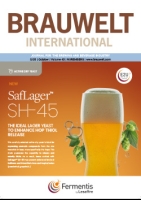In order to ensure that taste stability of beer is maintained in the longer term, the objective of this project was to obtain a better understanding of antioxidant action of polyphenols in the brewing process. With support from Wissenschaftsförderung der Deutschen Brauwirtschaft [EV], this research has been supported by funds disbursed by the Federal Ministry of Economics and Technology (BMWi) via the Working Group of Industrial Research Associations “Otto von Guericke” [EV] (AiF).
In Kleinheubach am Main, just a few kilometers away from the Ziemann manufacturing site in Bürgstadt, the Ziemann Group has set up an industrial scale pilot plant for the recycling of energetically relevant residue material from the brewing process. The plant is operated in collaboration with BMP Biomasse Projekt GmbH. The aim of the pilot plant is to secure process safety and reliability and also develop systems ready for production for the thermal recycling of brewing plant by-products.
Zambia, a country in Southern Africa with 11.6 Million inhabitants is world famous for the Victoria Falls on the Zambezi river and this magnificent natural feature is represented on the label of Mosi Lager brewed and packaged by Zambian Breweries, the country’s only clear beer brewery. The company not only brews Mosi but also produces several other lager brands as well as a leading range of carbonated soft drinks.
Current innovations in the beer market have primarily come from the large breweries. They view innovation as necessary for them to be able to remain relevant to their customer base. With their often very limited marketing budgets, smaller breweries are not nearly as inventive in thinking of ways of getting themselves noticed, and when the costs associated with marketing come into play, smaller breweries must choose strategies with even greater care.
In modern breweries CO2 recovery plants are common practice to provide for the CO2 supply of the brewery. With environmental awareness increasing and a general quest for potential cost reductions, energy saving possibilities are more important than ever. One of the most important parts of a CO2 recovery plant is the cooling system, a cost-intensive unit both with regard to the capital investment and energy consumption.
The depalletizing of kegs has always been a challenge for the brewing industry. Empty kegs are often returned to the filling plant randomly stacked. In addition to this, it is not unusual for individual layers of kegs to be incomplete. To ensure the maximum precision depalletizing of keg containers even when all conceivable adverse circumstances for depalletizing coincide, KHS has developed a special robot solution, which uses the latest in camera technology in conjunction with intelligent software.
Where will the path of beer innovations lead to? What possibilities are already available now, what does the future hold? The desire to develop (or to have to develop) “beery” beverages today that consumers will request tomorrow involves many risks.
Barley, one of the key ingredients of beer, was introduced in Italy by the Etruscans who, at their banquets used to drink a moderately alcoholic fermented beverage they called “pevakh”, originally made with rye and emmer and then wheat and honey. In Ancient Greece beer was considered as highly as wine, even becoming the official beverage of the Olympic Games, while in ancient Rome beer was much loved and drunk at banquets and feasts.
Consumers often judge food quality by its optical characteristics, e.g. by colour. Past experiences have shown how important such characteristics are for the sales success of food [1]. Besides its colour also the foam quality of beer is evaluated critically. Conclusions regarding different qualities of a beer (freshness, off-flavour etc.) are drawn on the basis of those two characteristics, hence they also influence future purchase intentions.[2].
Heineken expects EUR 135 million savings by the end of 2007. Like Molson Coors, like Heineken. Brewer Heineken expects to cut costs by EUR 135 million to EUR 155 million in 2007. It’s called the globalisation squeeze. René Hooft Graafland, Heineken’s Chief Financial Officer, said in a media interview in March that Heineken still plans to meet its cost-savings target of EUR 450 million, or EUR 200 million on a net basis, by 2008. He explained that 55 percent to 60 percent of those cuts would be completed by year-end.


